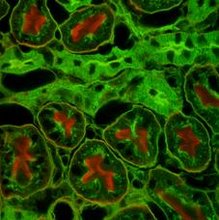Principle:
Cells in exponential phase of growth are exposed to a cytotxic drug. The duration of exposure is usually determined as time required for maximal dmage to occur, but is also influenced by stability of drug. After removal of drug cells are allowed to proliferate for two to three PDTs in order to distinguish between cells that remain viable and are capable of proliferation and those that remain viable but cannot proliferate. The number of surviving cells is then determined indirectly by MTT dye reduction. The amount of MTT-formazon produced can be determined spectrophotometrically once MTT formazon has been dissolved in suitable solvent.
Materials:
Sterlie :
Growth medium
Tryspnin (0.25 % + EDTA, 1mM in PBSA)
MTT: 3-(4,5-dimethylthiazole-2-yl)-2,5,diphenyl-tetrazolium bromide (Sigma), 50mg/ml, fiter sterilized
sorensson’s glycine buffer(0.1M Glycine, 0.1M NaCl adjustedto pH 10.5 with 1 M NaOH)
Microtitration plates (Iwaki)
pipettor tips , preferably in an autoclave tip box
petri dishes (non-TC treated) 5 cm and 9 cm or reservoir (Corning)
Universal container or tubes, 30 ml and 100 ml
Non-sterile:
Plastic box (clear polystyrene to hold plates)
multichannel pipettor
MSO
DMSO dispensor (optinal ) , Labsystem Microplate dispensor (Thermo , cat no 5840 127)
ELISA plate reader (Thermo , MultiskanEX)
Plate carrier for centrifuge (for cells growing in suspension)
Protocol:
Plating out cells:
Trypsinize a subconfluent monolayer culture and collect cells in growth medium containing serum
Centrifuge suspension (5min at 200g) to pellet cells,. Re-suspend cells in growth medium and count them
Dilute cells to 2.5 –50 X 103 cells /ml, depending on the growth of cell line and allowing 20ml cell suspension /microtitration plate.
Transfer cell suspension to a 9 cm petru dish and with a multichannel pipette add 200uL of suspension into each of central 10 columns of a flat bottomed 96 well pate (80 well perplate) starting with column 2 and ending with column 11, thereby placing 0.5 –10 X 103 cells into each well)
Add 200uL of growth medium to the eight wells in column 1 and 12. Column 1 will be used to blank plate reader, column 12 helps to maintain humidity for column 11 and minimize edge effect
Put plates in plastic lunch box and incubate in a humidified atmosphere at 37oC for 1-3 days such that cells are in exponential phase of growth at the time of when drug is added.
For non-adherent cells, prepare a suspension in fresh growth medium. Dilute cells to 5-100 X 103 cells/ml and plate out only 100 uL of suspension into round-bottomed 96-well plates. Add drug immediately to these plates.
Drug addition
Prepare a serial five fold dilution of cytotoxic drug in growth medium to give eight conc . This set of conc should be chosen such that highest conc kills most of cells and lowest kills none of cells. Once toxicity of drug is known smaller range of conc can be used. Normally three plates are used for each drug to give triplicate determinations within one experiment
For adherent cells remove medium from wells in columns 2 to 11. This can eb achieved with a hypodermic needle attached to suction line.
Feed cells in eight wells in column 2 and 11 with 200uL of fresh growth medium, these are the controls
Add cytotoxic drug to cells in columns 3 to 10. Only four wells are needed for each drug conc. Such that rows A-D can be used for one drug and rows E-H for second drug
Transfer drug solutions to 5-cm petri dishes and add 200 uL to each group of four wells with a four tip pipettor
Return the plates to plastic box and incubate them for a defined exposure period. For non-adherent cells prepare drug dilution at twice the desired final conc and add 100 uL to 100 uL of cells already in the wells
Growth period
At the end of drug exposure period, remove medium from all of wells containing cells and feed cells with 200 uL of fresh medium. Centrifuge plates containing non-adherent cells (5min at 200g) to pellet cells. Then remove medium, using a fine gauge needle to prevent disturbance of cell pellet.
Feed plates daily for 2-3 PDTs
Estimation of surviving cell numbers
Feed plate with 200 uL of fresh medium at end of growth period and add 50 uL of MTT to all of wells in columns 1 to 11
Wrap the plates in aluminium foil, and incubate them for 4 hrs in a humidified atmosphere at 37 oC . note that 4 hrs is a minimum incubation time nad plates can be left for up to 8hrs
Remove the medium and MTT from the well(centrifuge for non-adherent cells) and dissolve the remaining MTT formazon crystals by adding 200 uL of DMSO to all of wells in columns 1 to 11.
Add glycine buffer (25uL per well) to all of wells containing DMSO
Record absorbance at 570 nM immediately because product is unstable. Use wells in column 1 , which contain medium and MTT but no cells , to blank to the plate reader.
Analysis of MTT assay
Plot a graph of absorbance (y-axis) against the conc of drug (Y-axis)
Calculate IC50 as the drug conc that is required to reduce absorbance to half that of the control. The mean absorbance reading from wells in columns 2 and 11 is used as a control. Absorbance values in columns 2 and 11 should be the same. Occasionally, the are not , however, and this is taken to indicate uneven plating of cells across the plate.
The absolute value of absorbance should be plotted so that control values may be compared, but data can then be converted to % inhibition curve to normalize a series of curves.
Thursday, April 19, 2007
Subscribe to:
Post Comments (Atom)


No comments:
Post a Comment